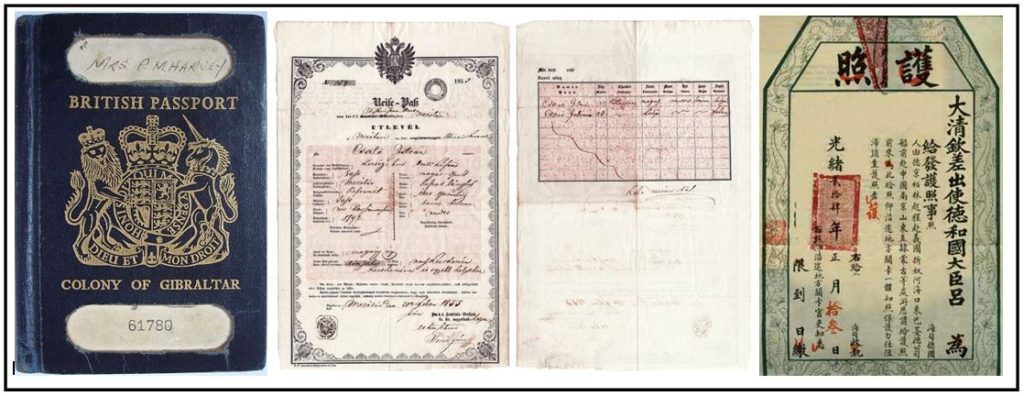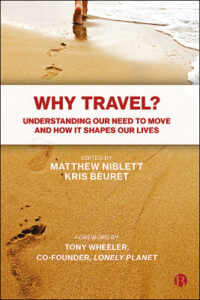Freedom to travel: A brief history of the passport

An assortment of old passports: a twentieth century passport from the Colony of Gibraltar; a Hungarian passport from 1855; and a Qing Dynasty Chinese passport from 1898*
A passport is, in modern days, an indispensable object for foreign travel. To some it symbolises freedom, but the passport can also be a tool of control and restriction. In a world where having the ‘right’ passport can mean the difference between life and death, or the hope of safety and prosperity, this small object can have a huge impact.[1] As a signifier of national identity, it can also be a source of patriotic pride – or disappointment – as has been seen in the UK recently with the announced post-Brexit return of Britain’s ‘old blue’ passport.
The history of the passport is long and complex, stretching back to at least 1500BC in Egypt, where people were required to have permission documents before leaving port. Over the following millennia, passport-like documents have been used for varying purposes in many different cultures, and their use has waxed and waned according to the political and economic tides of the time.
Protection
One of the roles of such documents has been to convey protection upon the traveller. In the Roman Empire folding tablets called tractoria were issued by the Emperor which entitled the bearer to assistance on their travels. And in a similar spirit, modern British passports still “request and require” that the bearer be afforded “such assistance and protection as may be necessary”. During war time many cultures have had the practice of issuing documents known as ‘safe conducts’, which help guarantee safe passage through enemy lands to those on diplomatic errands or to defectors. Such documents have been used by, amongst others, the Anglo Saxons, the Muslim rulers of Jerusalem in the Middle Ages, and the US Army during the Vietnam and Gulf Wars.
Permission
Perhaps the most fundamental role of the passport has been to convey and administrate permission to travel. In contrast to contemporary public debates around immigration, throughout its history the passport has been used by states as much to restrict the movement of their own citizens as to police who can enter. Many cultures have placed strict restrictions on their people leaving the country, sometimes to protect the traveller from danger and sometimes to prevent them emigrating and taking their skills and money with them. Many countries have also used passports domestically to control the movement of people within the country, with people required to have documents if they want to leave their local province. Such systems have been used in France, Imperial and Soviet Russia, China and Canada (where travel of First Nations people was restricted).[2]
Freedom and control
In giving permission to travel, the passport might be seen as bestowing ‘freedom’ upon the bearer; but at the same time it gives control over travel to the authorities who issue and check those documents. The history of the passport is replete with examples of the tension between the desire for freedom and for control. During the early Middle Ages, foreign travel from and to England was only permitted to those issued with the ‘King’s License’. In 1215, this system was challenged by Magna Carta which specified that anyone (except criminals) could leave the country freely. Such freedom of movement did not last long and the Crown soon regained the power to grant travel permission by issuing passports (a function which passed in 1540 to the Privy Council, and in 1794 to the Secretary of State), although passports were not compulsory for travel to or from Britain until the First World War. [3] France has a long history of compulsory foreign and domestic passport systems, with peasants being required to have written permission to leave their local area throughout the 17th and 18th centuries. These systems were abolished in 1792 in the aftermath of the French Revolution, as they were felt to be opposed to the revolution’s ideals of liberty and freedom. But the reign of ‘freedom’ did not last long: increasing lawlessness and mass emigration of skilled people and capital caused the Revolutionary Government to reinstate both internal and external passport systems just 3 years later.
During the 19th century, the growth of the railways and steam ships, the rise of the middle classes, and increasing emigration opportunities in the Americas, meant that the number of people able and wanting to travel abroad grew enormously. The administrative systems of most nations could not keep pace with the growing numbers of travellers and by the first decade of the 20th century most states had stopped using passports entirely. There was also a powerful group of voices within business and government circles who viewed the passport as a hindrance to commercial interests and who lobbied for the abolition of all passports. But again, the tide was to turn against freedom of movement and towards increased control of travel. The First World War changed the political landscape dramatically and, in an attempt to curtail the operation of enemy spies, European nations made passports and other travel and identity documents compulsory.
In the 1920s, meetings were held at the League of Nations to decide how best to deal with international travel administration, especially given the large numbers of displaced peoples in post-war Europe. Talks started out with debates about abolishing passports (a position still supported by the strong anti-passport lobby of the time), but the results of the conferences were increased standardisation of passports and a system for issuing passports to stateless refugees, rather than the abolition of travel documents.[4] As Martin Lloyd explains in his book The Passport, when peace time came, governments, and particularly the secret services, were not keen to relax passport requirements back to pre-war levels having “discovered how closely a population could be controlled.”[5] Many governments also did not want to give up the revenue generated by charging fees for passports (and associated visas) – income which funded some consulates entirely and often resulted in a net profit.[6] As the twentieth century wore on, standardisation and mechanisation of passports increased and governments became ever more reliant on the passport system in policing who was allowed to enter and leave their territory and tracking the movements of travellers.
As we explored in a previous blog post, freedom of movement has been a considered a crucial aspect of human life in many different cultures. For example, the Ancient Greeks considered it one of four fundamental freedoms, and more recently the freedom to live, work and move across national boundaries was enshrined in the treaty rights of the European Union. But conversely, human societies have also long sought to place some controls on this freedom, and, as we have seen, the passport has been a useful tool in that endeavour.
The Why Travel? Project
The Independent Transport Commission’s Why Travel? project aims to understand better our motivations for travel from a broad range of perspectives. The project looks at both ‘internal’ psychological and biological drivers as well as the economic, cultural and social structures we have created that all enable, control and shape our travel behaviour. Ultimately, this deeper understanding will help us to make better decisions in future regarding human travel and transport, and the myriad areas of life which travel touches on. For more information on the project, including news and expert views, see www.whytravel.org.
Notes:
Much of the information in this post has been gathered from Martin Lloyd’s book The Passport: The History of Man’s Most Travelled Document (2008), published by Queen Anne’s Fan: https://queenannesfan.co.uk/buy-books/martin-lloyd/passport/
* Images to be found at: https://commons.wikimedia.org/wiki/File:Gibraltar_old_passport.jpg; https://pixabay.com/en/hungarian-passport-1855-paper-3053806/; https://commons.wikimedia.org/wiki/File:QingPassport.jpg
[1] In his study of African refugees, academic Hadas Yaron writes of the ‘existential importance’ of the passport. Similarly, in his work Refugee Conversations, Berthold Brecht calls the passport “man’s most precious organ.” ojs.library.ubc.ca/index.php/newproposals/article/download/232/364
[2] For more information on the Canadian ‘pass system’ see: http://www.cbc.ca/news/aboriginal/dark-history-canada-s-pass-system-1.3454022
[3] https://www.theguardian.com/travel/2006/nov/17/travelnews
[4] For more on the Nansen Passport system for refugees see Lloyd (2008) Chapter 6, and http://theconversation.com/the-nansen-passport-the-innovative-response-to-the-refugee-crisis-that-followed-the-russian-revolution-85487
[5] Lloyd (2008) p. 130
[6] This has continued to the present day: in 2014 HM Passport Office reported an operating surplus margin of 15.1% https://assets.publishing.service.gov.uk/government/uploads/system/uploads/attachment_data/file/416152/2903572_HMPO_PRINT.pdf


